On the Trail of Two Monasteries

On the Trail of Two Monasteries
Wo Keng Shan Road is a pleasant little thoroughfare, a country lane with greenery flanking both sides and a graceful arc so that what lies ahead remains a mystery until you are almost there. In ancient times there was no road but there was a path. It connected Dapeng, to the east of Mirs Bay, and Nantou, to the west of Shenzhen. Two fortified cities both of which, today, are north of the border that separates Hong Kong from the rest of China.
These days travellers just roar up the Heung Yeun Wai Highway to the border crossing of the same name. Nobody knows how much, if any, of Wo Keng Shan Road follows the original path though it is always interesting to speculate. These days it is used almost exclusively by trucks heading to its, now rather less than inspiring, conclusion at the Northeast New Territories Landfill.
But that curve in the road still conceals a mystery that doesn’t reveal itself until you arrive.
Cheung Shan Monastery
This is one of the more remote monuments in Hong Kong. There are no buses or mini-buses and no taxis so unless you are driving the only way to get there is to walk the last stretch.


Exterior views of Cheung Shan Monastery showing murals and plaster mouldings
The 78K bus, which passes along Sha Tau Kok Road, can be caught outside either Sheung Shui or Fanling MTR stations. Get off at Loi Tung which is just after the the Heung Yeun Wai Highway intersection. From there you can follow the road back to the roundabout where you will find the start of Wo Keng Shan Road. Alternatively, navigate through the village and join it further up. Either way, the distance is about 1,300 metres.
The monastery, which is set back a little from the road, stands at the midway point between Dapeng and Nantou. It served as a welcome rest stop offering free tea and a place to relax, and perhaps reflect on the couplets written on either side of the entrance gate:
Long pavilion, parting in sorrow;
Ancient road, gazing at diverging paths — rain hats and dusty robes, travellers day after day.
Mountain birds sing of spring;
Temple flowers greet the dawn — smoky bells and wind chimes, my years pass year after year.

Part of the interior of Cheung Shan Monastery
It is thought that it also served as a relay station linked to the Wu Yang Post Station in Guangzhou and Hung Mui Post Station at Tai Yue Mountain.
No one knows when it was built, the oldest relic is a bronze bell which was cast in 1789 and indicates it was originally known as Cheung Sang Nunnery. A wooden plaque inside states that it was rebuilt in 1868. It became a monastery in 1949 after the buildings, which had been deserted for some time, were occupied by a monk named Kok San Kit.
The building is a simple two-hall structure with timber rafters and purlins. It stands on a slight incline, so the rear hall is slightly elevated, with a small courtyard between. Both exterior and interior are decorated with fine plaster mouldings and wood carving featuring dragons, phoenixes and other auspicious creatures. Buddha, Kwun Yum, the goddess of mercy also known as Guan Yin, and guardian of the earth, Tei Chong Wong are honoured here.
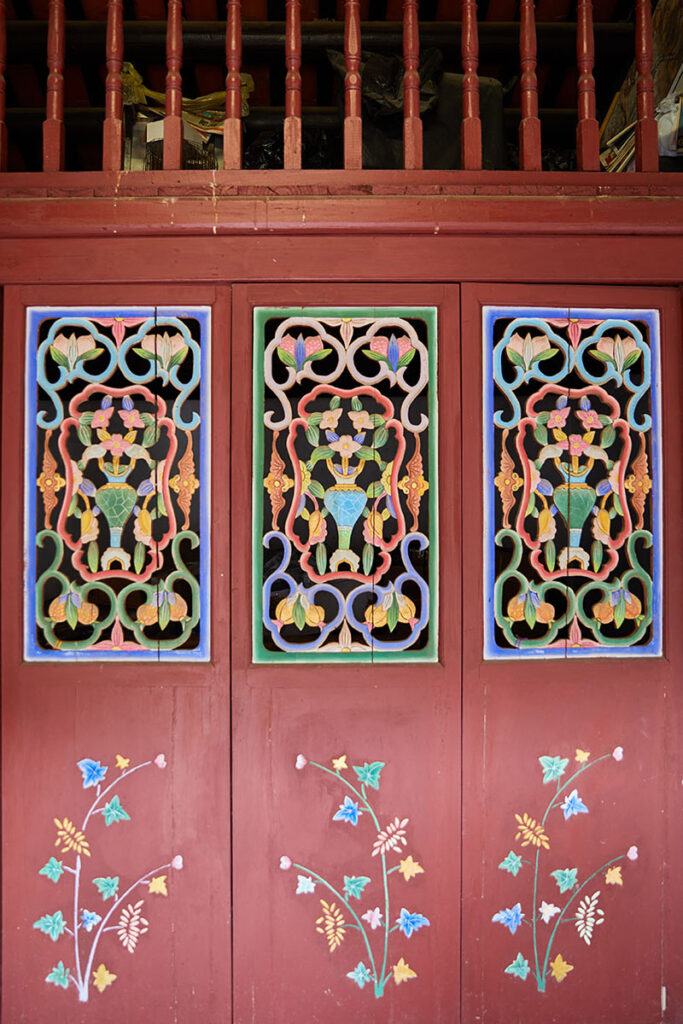
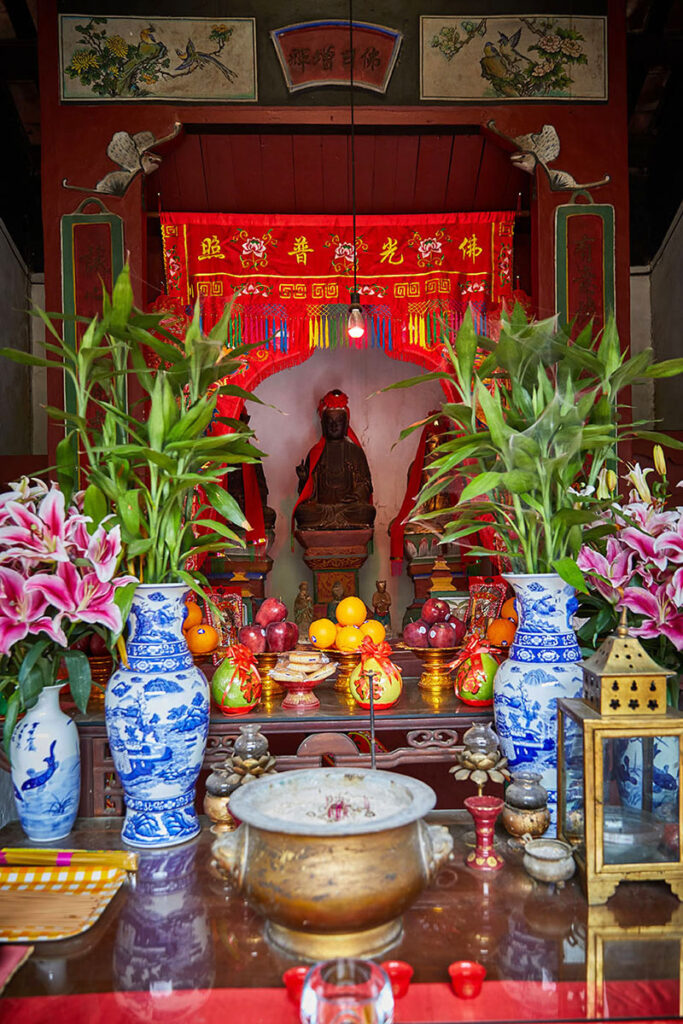
Decorative screen (left) and an Altar for the veneration of Buddha at Cheung Shan Monastery
The monastery was fully restored in 1997 and declared a monument a year later. Each year on the 18th day of the seventh lunar month, the monastery hosts a Yu Lan Festival, or Hungry Ghost Festival. Monks come to perform rituals and chant sutras and a vegetarian banquet is held for villagers to pray for peace and favourable weather.
Ping Yuen Tin Hau Temple
For those that don’t care to retrace their steps, and would rather stretch their legs than tuck them into another bus, it is possible to walk through to Ping Che Road. The next 500 metres along Wo Keng Shan Road are pleasant enough but shortly after it passes beneath the highway a left turn into Ng Chow Road is required.
From here the walk is not so pretty winding its way past steelyards, engineering and construction machinery, and the architecture of rusting corrugated metal and shipping containers. I must admit I do find a certain charm in its ugliness, a surreal beauty where small oases of nature still flourish despite the grit and the grime. But it is not everybody’s cup of tea.
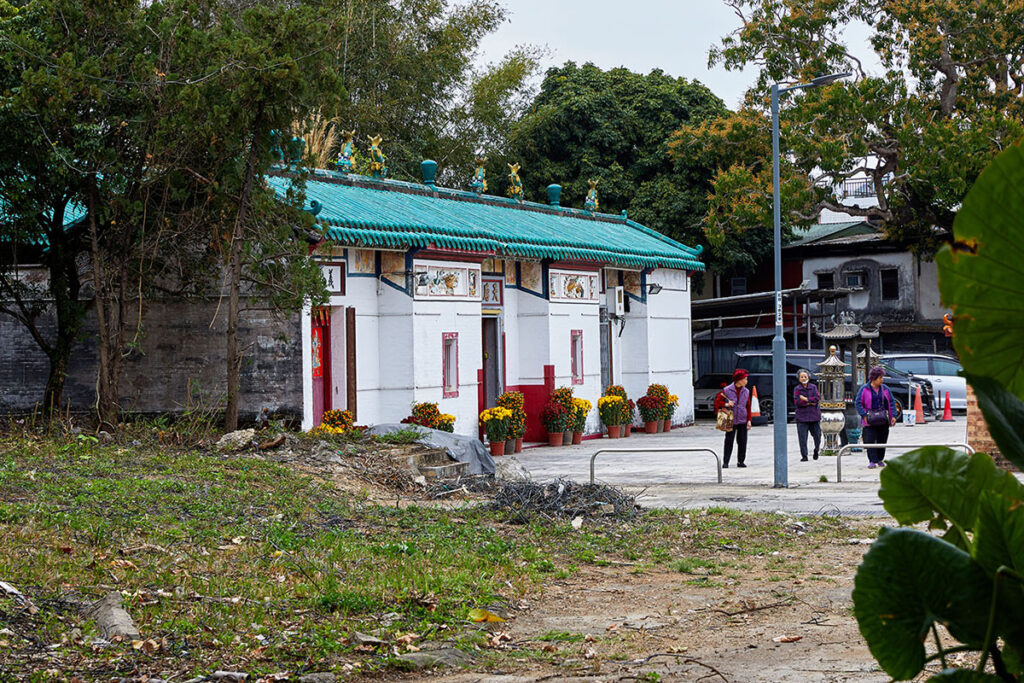
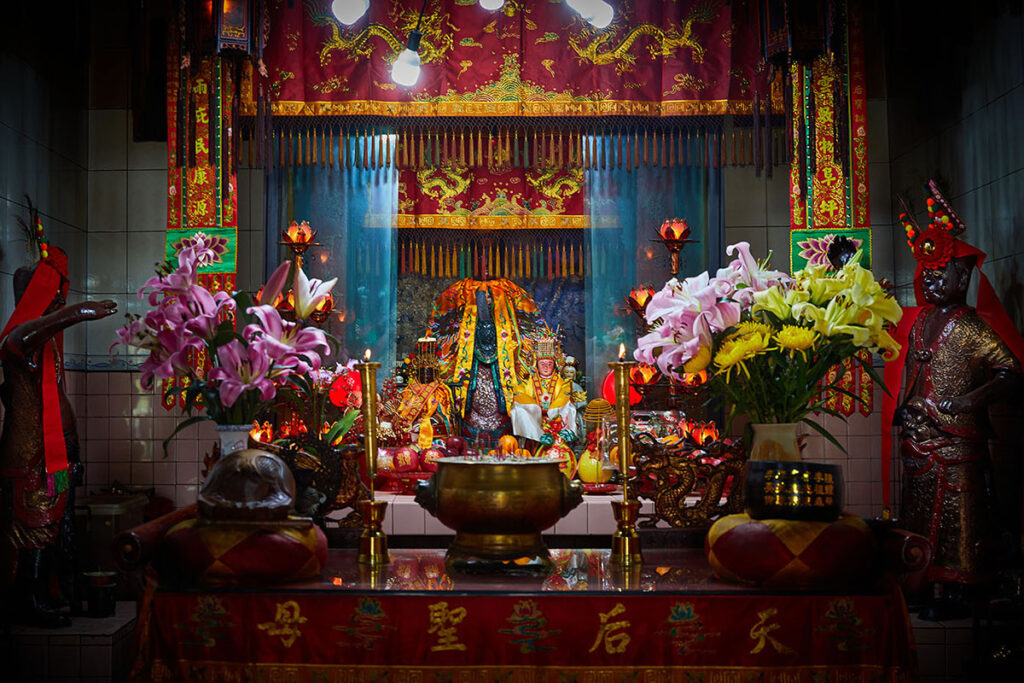
Tin Hau Temple, Ping Yuen
But it is not a long walk and the reward for the effort is the Ping Yuen Tin Hau Temple. According to an inscription on the bell the temple was built in 1756 by the villagers in the area. Much of the building has been modified over the years. The walls are painted white and the roof is covered with green ceramic tiles with aoyus, a mythical dragon fish, along the ridge. The timber rafters and purlins are still in place to support it all and the original reliefs and murals appear to have been kept
Attached to the left of the building is a communal hall which served as an office for the Ta Kwu Ling Rural Committee until 1968. On the right is the Hall of Justice where the ancestral tablets of of villagers who died in conflict with other villages are kept.
Despite the modifications the temple still retains its mystique. Incense fills the air, and the principal image of Tin Hau sits serenely partially hidden behind red silk banners, or chuang fan, embroidered with dragon motifs. Flowers, along with apples, oranges and pomelo fill the offerings table.
Wan Chuen Sin Koon
A right turn into Ng Chow South Road and again into Ping Che Road leads to Wan Chuen Sin Koon. This is a Daoist monastery belonging to the Chunyang Daoist sect, a branch of the Quanzhen school, which was founded in the mid-nineteenth century on Xiqiao Mountain near Nanhai City, Guangdong. It moved to Hong Kong in 1944 but the current premises have no historical significance. The land was acquired in 1975 and used as a religious retreat but it wasn’t until 2000 that construction got underway in earnest.
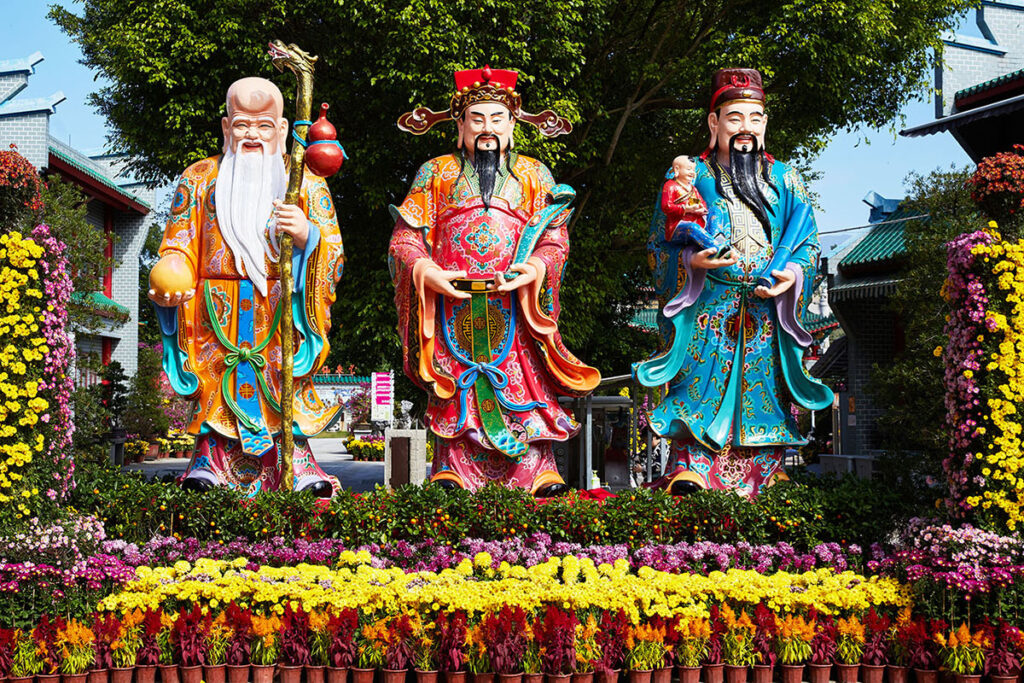
The three pure ones, Daode Tianzun wears yellow robes, Lingbao Tianzun in red, and Yuanshi Tianzun in blue
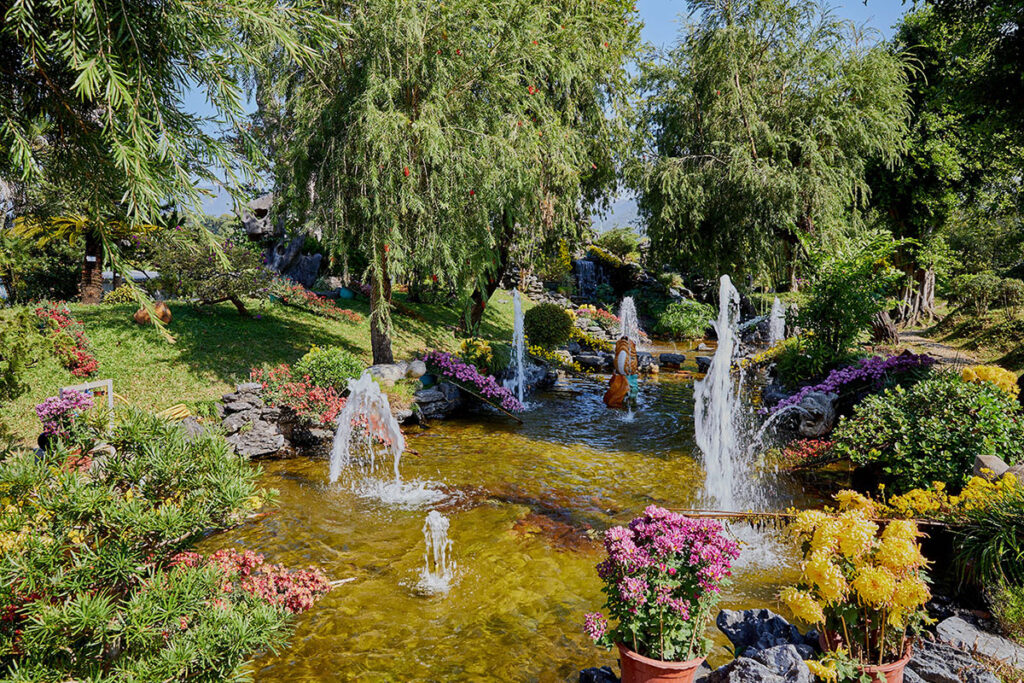

The gardens and grounds of Wan Chuen Sin Koon
On arrival, you are greeted by the three pure ones. These are types of energy represented in human form by three elderly gentlemen. Yuanshi Tianzun represents the beginning of creation, Daode Tianzun manifested his energy into the form of Laozi who is known as the founder or ancestor of the Dao, and Lingbao Tianzun who controls the present. The figures are dressed in robes of red, yellow and blue, the three primary colours from which all other colours are descended.
The monastery buildings are set within spacious grounds with lotus ponds and chrysanthemum gardens. The former blooms in late summer the latter in November or December when the grounds are filled with colour. Also on the premises is a large stele that contains the full text of Laozi’s Dao de Ching.
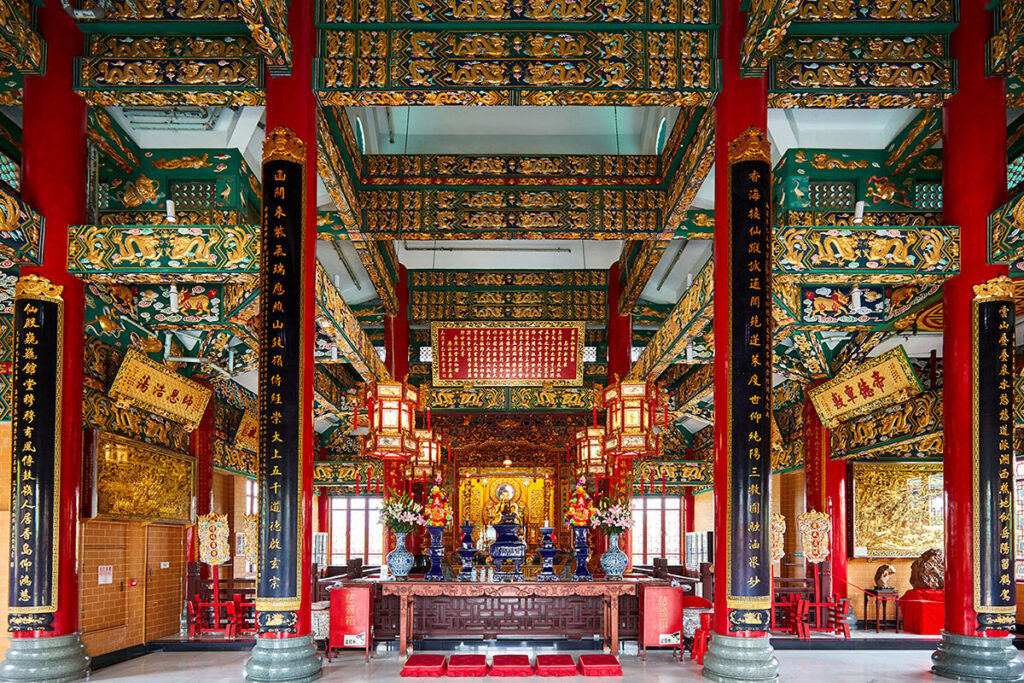
Chunyang Hall
The main building houses the splendidly ornate Chunyang Hall dedicated to the scholar and poet, Lu Dongbin. Red pillars with green crossbeams carved with flowers, dragons and other mythical beasts and finished with gold paint. Four large lanterns hang over an offerings table with fresh flowers and fruit. The image of Lu Dongbin, who is said to have lived from 618 to 907 CE, himself sits on an exquisitely carved altar surrounded by more dragons and flowers and a pair of phoenixes. He was elevated to a Taoist deity, and one of the eight immortals, early in the twelfth century. Since then his cult has expanded and he is now one of the most popular figures in Taoism.
At the rear of the building is a Tai Sui Temple. The Tai Sui are a group of sixty deities each in charge of a specific year in the sixty-year cycle of the Chinese calendar. The main image in the temple is of Doumu, the mother of the Big Dipper which in Taoist cosmology controls all human lifespans as well as the sixty-year cycle.

Doumu presides over the Tai Sui Temple
Wun Chuen Sin Koon is also famous for its excellent vegetarian lunches served between 12.00 and 14.00. First, go into the dining area and be assigned to your table. The tables are large so if you are a small group you will probably share. Once you have secured your table number cross to the opposite building and place your order. Portions are generous and tables fill up fast so get there early.
Related: When Buddhism came to Hong Kong
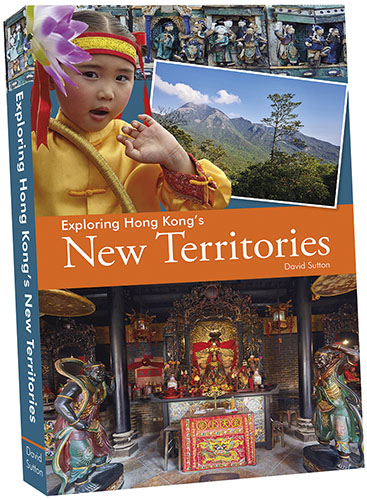
Exploring Hong Kong’s New Territories
The New Territories represents around 85% of Hong Kong’s total land area. It is an area of coastal wetlands and mountains boasting a history of more than a thousand years. There are many ancient monuments, well-maintained hiking trails and outlying islands with old fishing communities. Yet to most visitors, it remains largely unknown.
I spent the Covid years researching, writing and photographing it. Exploring Hong Kong’s New Territories is 332 pages with around 400 colour photographs plus maps and directions. More information here